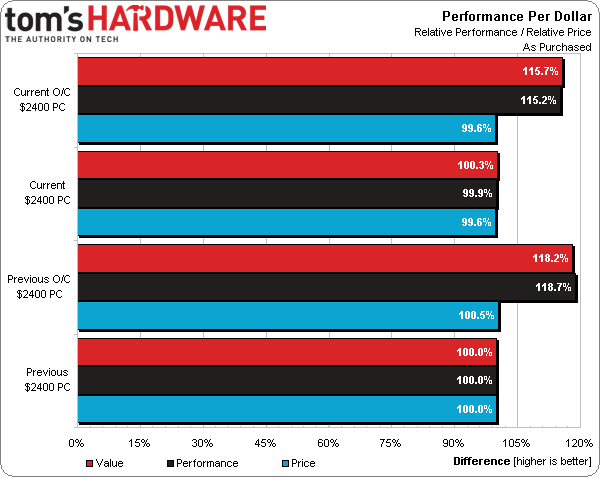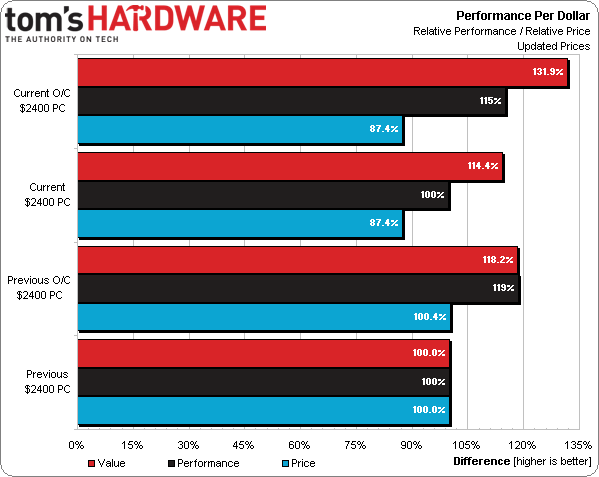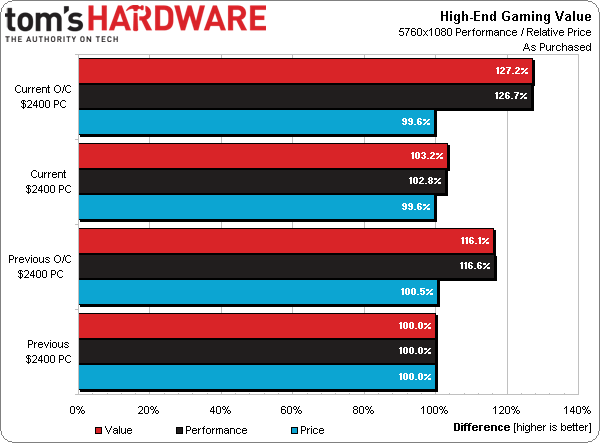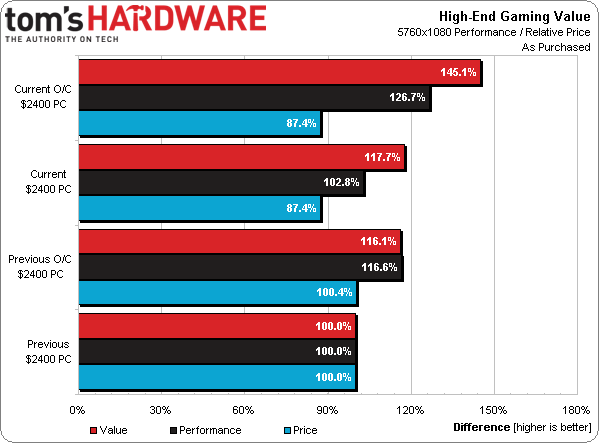System Builder Marathon, Q1 2014: The $2400 People’s Choice PC
A Gaming Build That Works Hard
A broad focus across our entire benchmark suite has caused many of my previous machines to look like workstations with gaming graphics cards. At least, that's what the feedback indicates. Occasionally, they end up behaving like gaming boxes with professional-class CPUs. A number of you asked for a change, and so today's effort was designed to facilitate a fresh perspective.
Slowed by Intel's enterprise-oriented storage driver, the previous build still managed to provide similar overall value to the game-centric replacement I pieced together today. Removing that stumbling block as I overclocked, the previous build’s less aggressive overclock manages to convey super value anyway.
But I still wouldn’t recommend the Q4 2013 setup today after what happened in the graphics market. Prices on Radeon R9 290s have shot up, and then dipped down a bit. But I'd only stand behind my choices if you could still find the Hawaii-based card for its original $400.
Comparing the prices of components today puts last quarter's top-end build at a huge disadvantage. If I were to choose my own multi-purpose performance-focused PC today, I’d need to figure out a combination of Ivy Bridge-E processor and Nvidia graphics cards that fit within a $2400 budget.
Gamers like gaming, and there are professionals who mix work and play. Although the previous build didn't please everyone, I can at least say that the new one caters to a crowd not dependent on business-class applications for making money. I don't even need consider price spikes on AMD's cards to see the current Intel/Nvidia-based build's gaming leadership.
Volatile pricing sounds the swan’s song for the previous PC’s Radeon R9 290 CrossFire configuration. I’m unlikely to revisit any AMD-based configuration until those cards can be purchased at October 2013 levels. Regardless of the reasons, your feedback driving my choices results in a better value this quarter.
Current page: A Gaming Build That Works Hard
Prev Page Power, Heat, And EfficiencyGet Tom's Hardware's best news and in-depth reviews, straight to your inbox.
-
Darkerson Interesting move, showing the nicest build 1st instead of last. Cant wait to see all the builds compared and see what you all come up with as the budget goes down.Reply -
captain_jonno Looks good. Surprised only went with a 750w PSU though. Considering 2x 780 ti's and overlockingReply -
Crashman Reply
Yessir, two 780s and a bit of experience in part picking lead me to expect around 700W of required system power. And, it came out just a little less than 700W.12951919 said:Looks good. Surprised only went with a 750w PSU though. Considering 2x 780 ti's and overlocking
Power supplies of greater capacity and similar reliability at this price tend to be lower-efficiency units. And we like efficiency too.
-
Crashman Reply
It's not calculated power, it's measured power for the entire system (at the power plug). No addition or subtraction was used.12952008 said:I dont get the "W" usage?680+237 = 917w. Not 802w as meation above?
1.) Start the system, wait for all processes to load, take a measurement (Active, but idle)
2.) Load the CPU using eight thread of AVX-optimized Prime95, take a reading (CPU Load).
3.) Load GPUs with 3DMark 11 Test 1 in loop, take max reading as it heats up (GPU Load).
4.) Load both applications (CPU+GPU Load).
The "math problem" is that any program used to fully load the GPU also partly loads the CPU. So when test 4 is Prime95+3DMark, Prime95 can only use whatever CPU resources are left with 3DMark running.
So the most accurate system power reading is with "CPU+GPU Load" applied. The system measurement for "CPU Load" still includes the power of an idle GPU. And the system power measurement for "GPU Load" still includes the amount of CPU energy it takes to run the GPU's test application.
-
YellowBee Reply12952046 said:
It's not a calculation, it's a reading for the entire system (at the power plug). Load the CPU using eight thread of AVX-optimized Prime95, take reading one. Load GPUs with 3DMark 11 Test 1 in loop, take max reading as it heats up.12952008 said:I dont get the "W" usage?680+237 = 917w. Not 802w as meation above?
The "math problem" is that any program used to fully load the GPU also partly loads the CPU. So when test 3 is Prime95+3DMark, Prime95 can only use whatever CPU resources are left with 3DMark running.
So the most accurate system power reading is with "CPU+GPU Load" applied. The system measurement for "CPU Load" still includes the reading of an idle GPU. And the system power measurement for "GPU Load" still includes the amount of CPU power it takes to run the GPU.
Very much appreciated and satisfying answer.
Thanks Crashman :) -
bemused_fred Reply
Any chance of including these calculations in all future articles, so that we know exactly how the power graph is calculated? Ta.
It's not calculated power, it's measured power for the entire system (at the power plug). No addition or subtraction was used.1.) Start the system, wait for all processes to load, take a measurement (Active, but idle)2.) Load the CPU using eight thread of AVX-optimized Prime95, take a reading (CPU Load).3.) Load GPUs with 3DMark 11 Test 1 in loop, take max reading as it heats up (GPU Load).4.) Load both applications (CPU+GPU Load).The "math problem" is that any program used to fully load the GPU also partly loads the CPU. So when test 4 is Prime95+3DMark, Prime95 can only use whatever CPU resources are left with 3DMark running.So the most accurate system power reading is with "CPU+GPU Load" applied. The system measurement for "CPU Load" still includes the power of an idle GPU. And the system power measurement for "GPU Load" still includes the amount of CPU energy it takes to run the GPU's test application.12952008 said:I dont get the "W" usage?680+237 = 917w. Not 802w as meation above? -
Crashman Reply
Which calculations?12952271 said:
Any chance of including these calculations in all future articles, so that we know exactly how the power graph is calculated? Ta.12952046 said:It's not calculated power, it's measured power for the entire system
-
jabuscus wow. such performance. many ram. they should've put in 16gb of ram for real high-end specs. ;)Reply -
Versutia As I'm into quiet enclosures, I'd go along this route:Reply
http://pcpartpicker.com/p/3fuGw
Wondering how much of a difference would non-reference cards make. Obviously, CPU cooler and RAM could be different, BR drive optional, storage drive as well.





